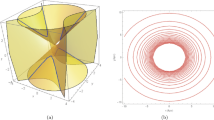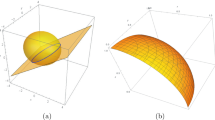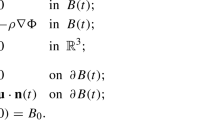Abstract
We study two-parametric families of spatial orbits given in the analytic form \(f(x,y,z)=c_{1}\), \(g(x,y,z)=c_{2}\) (\(c_{1}\), \(c_{2}\) = const.) which are produced by three-dimensional potentials \(V=V(x,y,z)\) inside a material concentration. These potentials must verify two linear partial differential equations (PDEs) which are the basic equations of the 3D Inverse Problem of Newtonian Dynamics and the well-known Poisson’s equation. A suitable class of potentials for this case is the axisymmetric potentials \(V=\mathcal{B}(x^{2}+y^{2}, z)\) which have applications in astrophysical problems. For the given density function \(\rho =\rho (x, y, z)\), \(\rho =\rho _{0}=const\)., or, \(\rho =\rho (z)\) and a pre-assigned family of orbits, three-dimensional potentials producing this family of orbits are found in each case. We focus our interest on the cored, logarithmic potentials and another one of fourth degree describing elliptical galaxies. The two-parametric families of straight lines in 3D space are also considered.




Similar content being viewed by others
Data Availability
No datasets were generated or analysed during the current study.
References
Andrle, P.: A third integral of motion in a system with a potential of the fourth degree. Bull. Astron. Inst. Czechoslov. 17, 169–175 (1966)
Andrle, P.: Density distribution corresponding to one potential of elliptical galaxies. Bull. Astron. Inst. Czechoslov. 38, 253–255 (1987)
Anisiu, M.: The energy-free equations of the 3\(d\) inverse problem of dynamics. Inverse Probl. Sci. Eng. 13, 545–558 (2005). https://doi.org/10.1080/17415970500170920
Anisiu, M., Bozis, G.: Two-dimensional potentials which generate spatial families of orbits. Astron. Nachr. 330, 411–415 (2009). https://doi.org/10.1002/asna.200811035
Anisiu, M., Kotoulas, T.: Construction of 3d potentials from a pre-assigned two-parametric family of orbits. Inverse Probl. 22, 2255–2269 (2006). https://doi.org/10.1088/0266-5611/22/6/021
Anisiu, M., Blaga, C., Bozis, G.: Special families of orbits in the direct problem of dynamics. Celest. Mech. Dyn. Astron. 88, 245–257 (2004)
Binney, J., Tremaine, S.: Galactic Dynamics, 2nd edn. Princeton University Press, Princeton (2008)
Bozis, G.: Szebehely’s inverse problem for finite symmetrical material concentrations. Astron. Astrophys. 134, 360–364 (1984)
Bozis, G., Grigoriadou, S.: Families of planar orbits generated by homogeneous potentials. Celest. Mech. Dyn. Astron. 57, 461–472 (1993)
Bozis, G., Kotoulas, T.: Three-dimensional potentials producing families of straight lines (fsl). Rend. Semin. Fac. Sci. Univ. Cagliari 74, 83–99 (2004)
Bozis, G., Kotoulas, T.: Homogeneous two-parametric families of orbits in three-dimensional homogeneous potentials. Inverse Probl. 21, 343–356 (2005). https://doi.org/10.1088/0266-5611/21/1/021
Bozis, G., Nakhla, A.: Solution of the three-dimensional inverse problem. Celest. Mech. 38, 357–375 (1986)
de Zeeuw, P.T., Lynden-Bell, D.: Derivation of the density distribution in a prolate galaxy from the rotation curve. Mon. Not. R. Astron. Soc. 232, 419–430 (1988)
de Zeeuw, T., Pfenniger, D.: Potential-density pairs for galaxies. Mon. Not. R. Astron. Soc. 235, 949–995 (1988)
Hernquist, L.: An analytical model for spherical galaxies and bulges. Astrophys. J. 356, 359–364 (1990)
Jaffe, W.: A simple model for the distribution of light in spherical galaxies. Mon. Not. R. Astron. Soc. 202, 995–999 (1983)
Kotoulas, T.: 3\(d\) homogeneous potentials producing isoenergetic families of orbits: an application to galactic dynamics. Astron. Nachr. 343, 1–9 (2022a). https://doi.org/10.1002/asna.20210023
Kotoulas, T.: Two-parametric families of orbits created by three-dimensional galactic-type potentials. Astrophys. Space Sci. 367, 69 (2022b). https://doi.org/10.1007/s10509-022-04096-9
Kotoulas, T.: 3\(d\) homogeneous potentials generating two-parametric families of orbits on the outside of a material concentration. Eur. Phys. J. Plus 138, 124 (2023a). https://doi.org/10.1140/epjp/s13360-023-03751-6
Kotoulas, T.: Families of orbits produced by three-dimensional central and polynomial potentials: an application to the 3d harmonic oscillator. Axioms 12, 461 (2023b). https://doi.org/10.3390/axioms12050461.
Kotoulas, T.: Semi-separable potentials as solutions to the 3d inverse problem of Newtonian dynamics. Symmetry 16, 198 (2024). https://doi.org/10.3390/sym16020198.
Kotoulas, T., Bozis, G.: Two-parametric families of orbits in axisymmetric potentials. J. Phys. A, Math. Gen. 39, 9223–9230 (2006). https://doi.org/10.1088/0305-4470/39/29/015
Miller, R., Smith, B.: Dynamics of a stellar bar. Astrophys. J. 227, 785 (1979)
Pfenniger, D.: The 3d dynamics of barred galaxies. Astron. Astrophys. 134, 373–386 (1984)
Puel, F.: Intrinsic formulation of szebehely’s equation. Celest. Mech. Dyn. Astron. 32, 209–216 (1984)
Puel, F.: Explicit solutions of the three dimensional inverse problem of dynamics using the Frenet reference system. Celest. Mech. Dyn. Astron. 53, 207–218 (1992)
Shorokov, S.: Solution of an inverse problem of the dynamics of a particle. Celest. Mech. 44, 193–206 (1988)
Szebehely, V.: On the determination of the potential by satellite observations. In: Proverbio, G. (ed.) Proceedings of the International Meeting on Earth’s Rotation by Satellite Observation, pp. 31–35 (1974)
van der Kruit, P.: The three-dimensional distribution of light mass and mass in disks of spiral galaxies. Astron. Astrophys. 192, 117–127 (1988)
Funding
There were no funds for this work to the author Thomas Kotoulas.
Author information
Authors and Affiliations
Contributions
This work was done by the author: Thomas Kotoulas (T.K.). He wrote the main manuscript text, solved the equations, obtained results and verified them by using the program MATHEMATICA 11.0. He prepared the Figs. 1-4. All authors reviewed the manuscript.
Corresponding author
Ethics declarations
Competing interests
The authors declare no competing interests.
Additional information
Publisher’s Note
Springer Nature remains neutral with regard to jurisdictional claims in published maps and institutional affiliations.
Rights and permissions
Springer Nature or its licensor (e.g. a society or other partner) holds exclusive rights to this article under a publishing agreement with the author(s) or other rightsholder(s); author self-archiving of the accepted manuscript version of this article is solely governed by the terms of such publishing agreement and applicable law.
About this article
Cite this article
Kotoulas, T. Two-parametric families of orbits produced by 3D potentials inside a material concentration: an application to galaxy models. Astrophys Space Sci 369, 53 (2024). https://doi.org/10.1007/s10509-024-04313-7
Received:
Accepted:
Published:
DOI: https://doi.org/10.1007/s10509-024-04313-7




